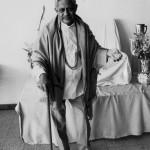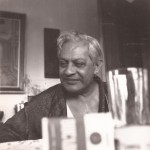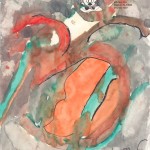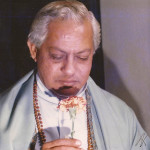The secret in contemplation

JEFF: Tamaji and I were remarking that the way contemplation was described was very very similar to the way painters paint pictures in the sense that many people have the idea that a painter has a preconceived notion of the painting. That they have a theme they are pursuing very actively, and that they think a lot about what’s going on. In actual fact, the painters that I know, and I myself, you really have a general thing you want to paint, let’s say a person or a landscape, but once you start painting there is very little thinking going on, except when you realize very suddenly, you think that there’s a problem, or you step back from the painting. Guruji was saying last night that you can step back from something and look over the whole thing without breaking the flow of contemplation, but it does occur when a painter sometimes looks back. Painters do this: look at the painting, go back and paint. They step back, look at the painting again. But sometimes you think that there is a problem or something is disharmonious. At that stage painters know that if you let the painting . . . if you think about it too much, you’ll do something called «losing the painting» which means it has a whole bunch of problems and you start fussing with it. At that point it will turn out to be a wreck. Painters have different strategies for dealing with this. One is that they literally paint out a big area of the painting, even parts that work. Paint out a whole area, just so when you start painting again you will reestablish that flow. Some painters call it keeping the painting open. Some painters call it not losing contact with the painting, but it’s really a very important part. I notice that students sometimes spend ten years working mentally with paintings that are all awful, and really, when you paint there is really very little actual mental. . . I don’t know how to . . . what would you say Guruji, mental analysis.
GURURAJ: Yes, because the mental analysis stops the flow. Very good. Thank you, Jeff.
Good, we just started the ball rolling. In other words, in contemplation, in spite of you having to stand back as Jeff so very well explained, the continuity, as I described yesterday, while making a film, the continuity must not be disturbed. For if it is disturbed, then you and the painting become apart from each other. But while the contact is maintained, you are the painting and the painting is you. Fine, and that is the contact. The poem I gave you yesterday, it took me two minutes to write. I’m a prolific writer when I feel like it. And that is to give you the idea that you are the all, you are the divine and do not think of yourself to be that little worm crawling on the floor perhaps. Even that worm is divine too. So if one establishes in oneself knowingly and realizes it (that’s important) that one is divine, then all the negative qualities of depression, manic depression, frustration, all of the kinds of negativities, worries, anxieties they all disappear. For then you would say what does this matter. Really, it is so temporary, while I am divine and eternal. But, now, what I wish to say is this, that you could use that poem, make a copy of it. I’m sure it’s on the other side of the board, Sutriya? Make a copy of it if you like it, or else you could use any other passage that you are fond of, any scriptural passage. But try and use something, you know, very uplifting to yourself which would be good. Instead of once upon a time there was a maiden, you know, who… etc., etc. Never mind what happened to her. Something uplifting, that’s important.
Good, now Jeff has started us off by what he understood by contemplation. He had a chat with Mataji who is also an artist, and of course Jeff is a teacher of art. And his dear wife Lorieta is also an artist‑‑I have some of her paintings hung up on the walls at home. They are beautiful and whoever comes and visits me admires them, especially that very pale blue one with birds flying. That is my favorite. Good. Let’s leave it to the audience to ask questions. Yes!
JAMMU: Guruji, what you described as being contemplation reminded me of the raja yoga sutras by Patanjali where he describes something called samyama. It is the uninterrupted flow of the mind toward an object, which, after a certain duration, becomes samadhi and after bla, bla, bla . . . you get nirvikalpa.
GURURAJ: That is very true. Let me give you a brief explanation. Contemplation is not samyama. Samyama is the feeling of oneness with the object. But before that comes along you got to have dhyana dharana and samadhi. And this is achieved by the one previous to that called pratyahara.
Now pratyahara means withdrawing within yourself all your senses, where you are not conscious of your senses. So your painting, as in this case we described, has nothing to do with your senses, but an inner flow. Of course your senses would be observing it and that is how all great poems are written. For example, when I write a poem I’m not conscious of it at all. And many nights I would write a poem, and the next morning I would read it and ask myself, «Did I write this?» You see, because it was that flow of the moment. And then, after pratyahara you have dhyana dharana and samadhi which is the superconscious state.
Now all these put together make sumyama, which leads you to know and realize that you and I are one. And then the further step, as you have said, in nirvikalpa samadhi would be that you and I are not only one, but you are I and I am you. I am the all in all for I am the all. That poem of last night, that’s how it works.
So samyama is a combination of the eight limbs of raja yoga which was written by Patanjali. I’ve written many articles on raja yoga. I’ve found a lot of contradictions in Patanjali according to today’s technological standard, and, of course, which was good, and of course, interpreting what he really tried to say. He did put a lot of emphasis that in the practice of raja yoga you would gain so many different types of powers, psychic powers like feeling as light as a feather and you can float, levitate. If you want to know more about levitation go to Maharishi, because none of his people has levitated yet. And he tells you how you can become heavy, like a big rock and nothing can shift you. Where you can hear sounds from a great distance. You develop that instinctive ability of a dog. Your smell is enhanced. Things like that. Those are the things he puts great emphasis.
But those are only to do with psychic powers and psychic powers are of a very low level. So therefore I can teach you all these things and how to achieve them, but they will not benefit you. You will get so involved in psychic powers that you will lose the aim of finding yourself to be one with God that I and my Father are one. That is the aim of life. And developing psychic powers could be very, very dangerous to you emotionally, psychologically. Because through the practice of this there is a whole change in structure of the brain that causes all these psychological disturbance, and all these neuroses and psychoses and things like that. While in the practice of our form of meditation you will acquire, as time goes by, many of these powers, but you will not pay importance to it. You pass a lovely garden and admire the flowers and you pass on. That happens.
One thing I’ve found with our meditators is this, that they have become more and more creative. Now, to become more creative, you become more in touch with yourself. I can give you many examples among people sitting here. Let’s take Roopa, for example. I used to get letters from her, I think I’ve known you for about ten years you’ve been with me. And she writes to me regularly. And of course I don’t reply to her by letter, there are other means of communication. Good. And now and then, in those days she used to write poems. But if you read the poems of today that she writes they are so beautiful, filled with so much depth. She does not only look at this carpet in her poetry but goes under the carpet and finds out how the carpet is held up. There is great depth, greater creativity has been formed there. Many people’s anxieties have been lessened. Many good things have come about. For example, let us take Rajesh and Jasmini. They had the potential of being karma yogis that would work for the sake of work. Those are karma yogis. They had the potential of being devoted. And with their practices they are so much, much, much much, much (I could repeat that a million times) so much, much more devoted and wonderful workers. I could just pick up the phone from Cape Town to Rajesh or Jasmini and say I want to have this thing done and it is done immediately. Because I wouldn’t ask someone to do something just for the fun of it. If it’s something important, of course. Firstly, I can’t afford to make phone calls overseas unless it’s of real importance.








Speak Your Mind